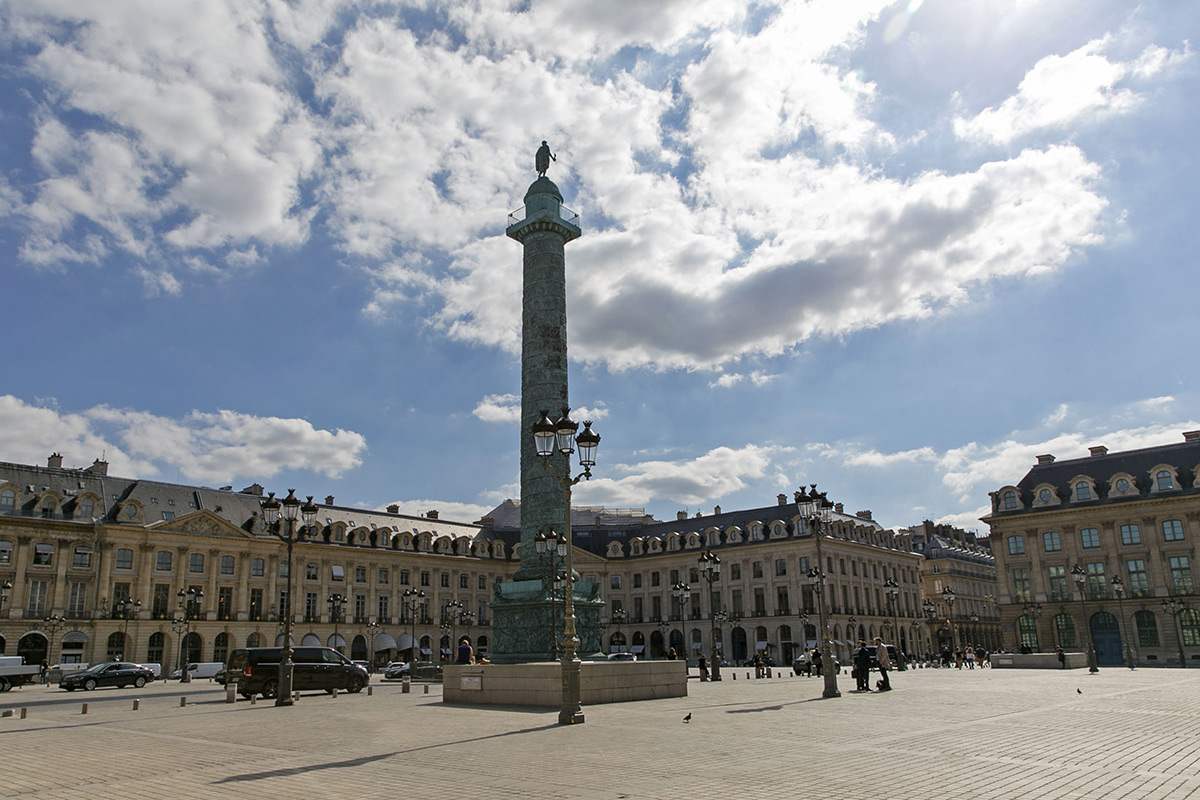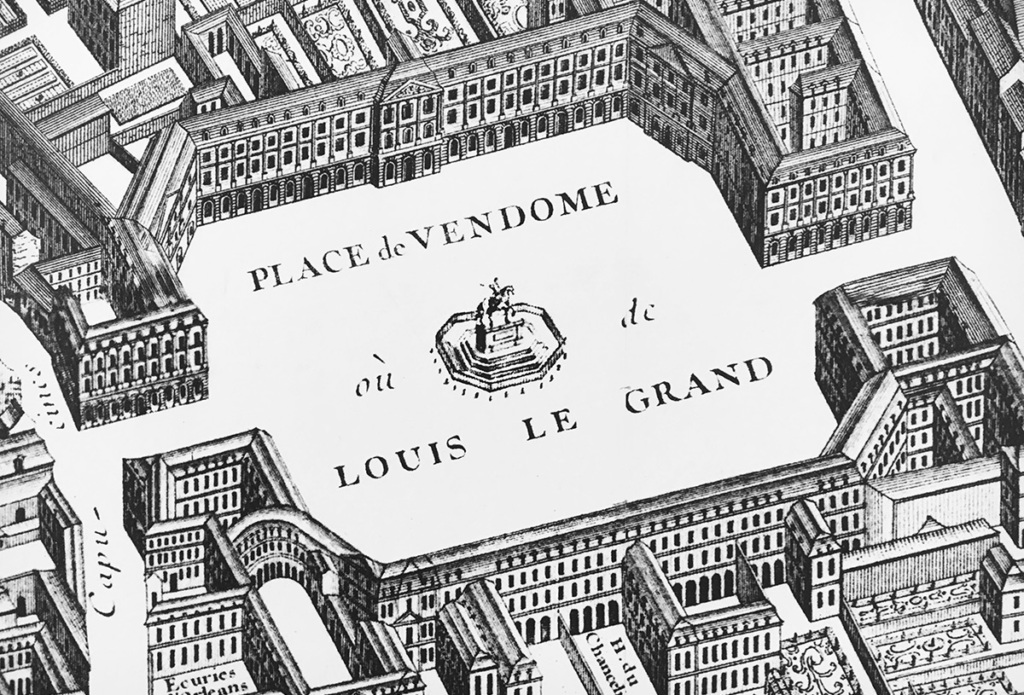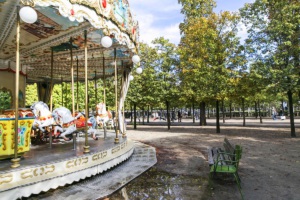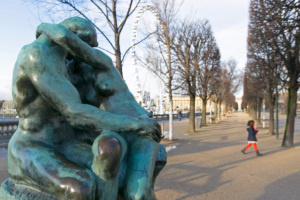Place Vendôme, named after the mansion that was originally built there, is a square around which the surrounding area gravitates, from the Madeleine to the Louvre and along the Rue de Rivoli. It has long been the shining star of luxury à la française. It arouses envy and inspires artists. Visitors from the world over make no mistake, this is where they come to daydream in front of the luxury jewellery stores, enchanted by the charm of this fabulously Romanesque neighbourhood, where the greatest fortunes have been made, and lost.

A royal square, and an architectural star from its beginnings
Louis XIV came up with the idea of “opening up” Paris and he wanted to leave his mark on the city — so Place Vendôme was designed by Jules Hardouin-Mansart, the king’s architect.
On the site of the former home of the Duke of Vendôme, he decided to build a vast square surrounded by a dozen public buildings (a royal library, royal academies, a mint, embassies, etc.). At the centre was a bronze equestrian statue of Louis XIV, more than seven metres tall. Construction of this immense project began in 1690 and was inaugurated unfinished in 1699, due to lack of finances. In fact, behind the majestic façades of the vast square, there was nothing. It was all just a front!
A few months later, the land was sold to the city of Paris, the buildings were knocked down and the operation fully privatized. Soon the square would be home to luxurious private mansions financed by the nobles of the capital. There was just one rule to be respected, and that was that the façades had to be strictly identical, all designed by Jules Hardouin-Mansart. This remains the rule today.
Extending into the Carrousel and Tuileries gardens
between the Rue de Rivoli and the Seine
These two parks, created in the 19th and 16th centuries respectively — the first at the site of the Palais de Tuileries, which burned down in 1871, and the second on the site of the former royal tile kilns — are the “green lungs” of the area. The Tuileries, created under Louis XIV at the instigation of Jean-Baptiste Colbert, is the oldest French-style garden in Paris. Redesigned by André Le Nôtre and completed by his grandson, Pierre Le Nôtre, it has mostly maintained its original aspect. A public park since it opened, designed for people to meet, chat and get some fresh air, it has always had restaurants and cafés on its terraces. The walkways are lined with large classical sculptures, to keep the daydreamers who stroll there company. More modern works by Aristide Maillol, Auguste Rodin, Louise Bourgeois, Henry Moore and others began to join them in 1964. Today, just like yesterday, families and lovers wander through the gardens, wherever the wind takes them. For fans of sensory and bucolic experiences, don’t miss the “Jardins, jardin aux Tuileries” event. Every year, the gardening fair offers visitors the chance to discover magnificent temporary gardens.
A literary reference, a Romanesque site and a muse
With its jewellery shops, banks, luxury fashion houses and palatial hotels, the area around Place Vendôme is a stage for the greatest love stories and tragedies of household names that travel there from the four corners of the globe. The most beautiful place for an intriguing story is of course the Ritz. It is the only five-star hotel on the square, and has become a fictional character in its own right, given the number of times it is quoted in literature. Colette described the experience as being “wrapped up in a sealskin”. Marcel Proust, who enjoyed dining there, mentions it in his correspondence: “Ladies in night-dresses, and even in dressing gowns, wander the arched lobby, tightly clutching pearl necklaces.” The place for the beau monde to be is featured in several chapters of “In Search of Lost Time”: “On those evenings, the Ritz Hotel must seem like the Hôtel du Libre Echange” (Time Regained). Proust observed its clientèle from its inauguration in 1898 and appreciated the hotel’s setting: “The moonlight appeared as a gentle flow of magnesium that let me take in one last time the nocturnal images of these beautiful places such as Place Vendôme…”.
Coco Chanel, who lived at the Ritz, remembered that in 1917, “Proust went to meet a hotel servant up in the attic. He paid him to write down the names of all the guests, what they’d eaten, how they were dressed. […] Everyone wanted to appear their best in Proust’s eyes, out of fear or desire to be used as a model for one of his characters.” For Léon-Paul Fargue, “the Ritz, so calm and dazzling, so well designed for the beau monde to relax, is actually a world of novels”. (Le piéton de Paris). Francis Scott Fitzgerald found inspiration there. Sitting in the Ritz lobby, he saw the woman of his dreams walk by. Captivated, he ordered a bouquet of orchids to be brought to her. The beautiful woman sent the flowers back and the writer, quite inebriated, devoured the petals one by one in front of her. She gave in to his advances the same evening. That was his inspiration for The Diamond as Big as the Ritz, which he wrote later on the Côte d’Azur, setting the scene on the other side of the Atlantic. But Scott Fitzgerald’s contribution to the literary glory of the place is mostly due to his friendship with Ernest Hemingway, who introduced him to the hotel. Hemingway lived there, and legend says that it was even he who “liberated” the Ritz on 25 August, 1944. He arrived with an armed commando, and immediately ordered “50 martinis”. That day, he was celebrating the liberation of Paris — and his birthday.



